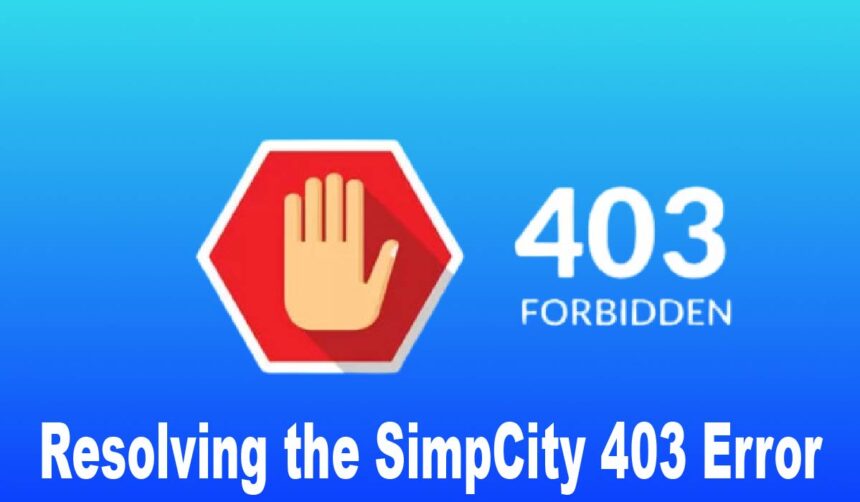Introduction
The SimpCity 403 Error is a common stumbling block for many users navigating online resources or applications. This error indicates that access to the requested resource on the server is forbidden despite the request being valid. Unlike more cryptic error messages that might leave users puzzled, the 403 Error explicitly informs users that they do not have permission to view the desired resource.
Addressing this error is crucial because it can impede user experience, restrict access to necessary information, and affect productivity, especially when dealing with web applications and services. This article will delve into what the SimpCity 403 Error is, explore its causes, and provide a detailed guide on diagnosing and resolving these issues. We’ll also cover preventative measures to help ensure the error does not recur.
What is the SimpCity 403 Error?
A 403 Forbidden Error in the context of SimpCity is an HTTP status code that occurs when a server understands a request but refuses to authorize it.
This is distinct from a 404 Not Found error, which indicates that the requested resource does not exist, and a 500 Internal Server Error, which points to a general server malfunction.
The 403 Error specifically means that access to the resources is denied, regardless of whether it exists.
This error can appear under various circumstances, such as when users try to access certain web pages or features without the necessary permissions or when server configurations block users from accessing content based on specific criteria like geolocation or IP address.
Common Causes of the SimpCity 403 Error
Incorrect File or Folder Permissions: If the permissions aren’t set correctly, the server might block access to files or folders that should be accessible.
Misconfigured .htaccess File: Errors in this configuration file on Apache servers can restrict access unnecessarily.
Server-Side Restrictions: Sometimes, access is blocked based on your IP address or geographical location due to set server restrictions.
Client-Side Issues: An Outdated or corrupt browser cache and cookies can sometimes cause a 403 error by presenting outdated credentials or session data to the server.
Diagnosing the SimpCity 403 Error
Using Browser Developer Tools: These tools help you inspect the HTTP responses you get. If a 403 status code shows up, it confirms that the error is due to forbidden access.
Checking Server Logs: Server logs can give you a detailed look at what happened when the error occurred, helping pinpoint why access was denied.
Reviewing the .htaccess File: This file controls access on Apache servers. Checking for incorrect entries that might be causing access denials is crucial.
Examining File Permissions: Using FTP clients or command-line tools to check file permissions ensures that the server settings allow user access.
Step-by-Step Troubleshooting Guide
Clear Browser Cache and Cookies: Start by clearing your browser’s cache and cookies. This can resolve issues stemming from outdated or corrupted data that might be stored in your browser. Go to your browser settings, find the privacy or history section, and choose the option to clear browsing data, including cache and cookies.
Check File and Directory Permissions: Use an FTP client or a file manager in your hosting control panel to check the permissions on the files and directories you are trying to access. Files typically should have a permission setting of 644, and directories should be set to 755. If they aren’t, change them accordingly to ensure they can be accessed correctly.
Review the .htaccess File: If your website is hosted on an Apache server, the .htaccess file could be the cause of the 403 Error. This file is used to control access to certain parts of your site and can restrict access if configured incorrectly. Look for directives like Deny from all or Require all denied and adjust or remove them as needed.
Contact Hosting Provider or Web Administrator: If you have checked the above and the issue persists, it may be time to contact your web hosting provider or the administrator of the web server. They can provide insights into server-side settings or restrictions that might be causing the 403 Error.
Disable Security Plugins or Extensions: Sometimes, security plugins or browser extensions can mistakenly block legitimate access. Try disabling these plugins one by one to see if the error resolves. If it does, you’ve found the culprit and may need to adjust the settings or replace the plugin.
Switch Networks or Use a VPN: If the server is restricting access based on IP addresses or geo-locations, trying to access the resource from a different network or using a VPN can be a useful diagnostic tool. This can help you determine if there are IP-based or geo-restrictions causing the error.
How to Prevent Future SimpCity 403 Errors
Regularly Update Permissions: Ensure that file and directory permissions are consistently reviewed and correctly set. Files should generally have permissions set to 644, and directories to 755. This prevents unauthorized access while allowing legitimate users to view and interact with content as necessary.
Maintain Accurate .htaccess File Configurations: For sites on Apache servers, the .htaccess file is a powerful tool that can also cause significant issues if not configured correctly. Regular checks and updates to this file can prevent misconfigurations that may lead to 403 errors. Make sure rules in the .htaccess file are necessary and correct, and remove or adjust any that cause unintended access blocks.
Keep Software and Plugins Updated: Outdated software and plugins can not only pose security risks but also cause compatibility issues, including potential 403 errors. Regular updates ensure that all components of your system are functioning as intended and are secure.
Audit Server and Network Configurations: Regular audits of server settings and network configurations can help identify and rectify settings that might inadvertently restrict access. This includes firewall settings, IP whitelist/blacklist, and other access controls.
Educate Users and Administrators: Ensure that all users, especially those with administrative access, are aware of the actions that might trigger a 403 error. Training on proper file handling, security practices, and understanding the impact of server configuration changes can reduce human error-induced issues.
Use Reliable Hosting Services: Choose a web hosting service known for reliable performance and good customer support. Quality hosting can reduce the chances of server misconfigurations that lead to 403 errors.
Monitor and Respond to Alerts: Implement monitoring tools that can alert you to potential access issues as they arise. Early detection can prevent a small misconfiguration from becoming a bigger problem.
Expert Tips and Additional Resources
Handling a SimpCity 403 Error effectively requires a blend of technical know-how and practical experience. Web developers and IT professionals recommend regularly reviewing server and client-side settings to ensure they align with security best practices and user access requirements. Several online resources are available for those looking to deepen their understanding of HTTP status codes and server configurations, including detailed guides on Apache and Nginx server management and forums where experts share their insights and solutions.
Conclusion
The SimpCity 403 Error, while frustrating, is a manageable issue with the right approach and understanding. By recognizing the causes of this error and following a structured troubleshooting and prevention plan, users and administrators can effectively address and prevent this error. This guide provides a thorough framework for understanding, diagnosing, and resolving the 403 Forbidden Error, equipping you with the knowledge to ensure smooth and uninterrupted access to web resources. Remember, when in doubt, reaching out to knowledgeable support professionals can provide additional assistance and insight into resolving these issues efficiently.
(FAQs) Frequently Asked Questions
What exactly is a SimpCity 403 Error?
A SimpCity 403 Error is an HTTP status code that indicates you do not have permission to access the requested resource on the server. This can happen even if the resource exists and your request is valid.
Why am I seeing a SimpCity 403 Error?
You might see a SimpCity 403 Error for several reasons, such as incorrect file permissions, misconfigured .htaccess files, server-side restrictions based on IP or geo-location, or outdated cache and cookies on your client-side.
Can clearing my browser cache fix a SimpCity 403 Error?
Yes, sometimes clearing your browser’s cache and cookies can resolve a SimpCity 403 Error, especially if the issue is due to outdated or corrupted data that your browser is storing.
What should I check if I have all the correct permissions but still get a 403 Error?|
If permissions are correctly set and you still face a 403 Error, check the .htaccess file for restrictive directives that might be blocking access. Also, ensure there are no server-side IP restrictions or configurations that might be causing the error.
Is it possible to prevent SimpCity 403 Errors from recurring?
Yes, you can prevent recurring SimpCity 403 Errors by regularly updating your file permissions, ensuring your .htaccess file is correctly configured, keeping your browser and plugins updated, and conducting regular audits of your server and network settings. Educating users on best security practices can also help minimize human errors that might lead to such errors.
For More Amazing Updates And News, Follow Emperor Magazine







